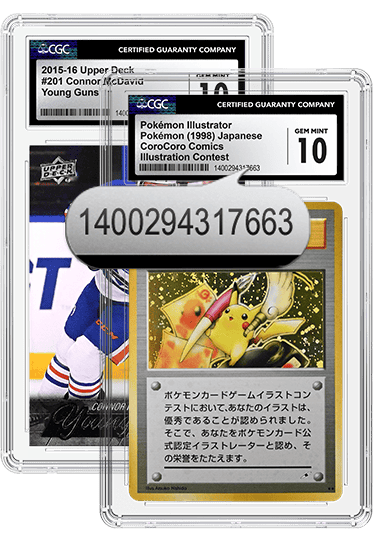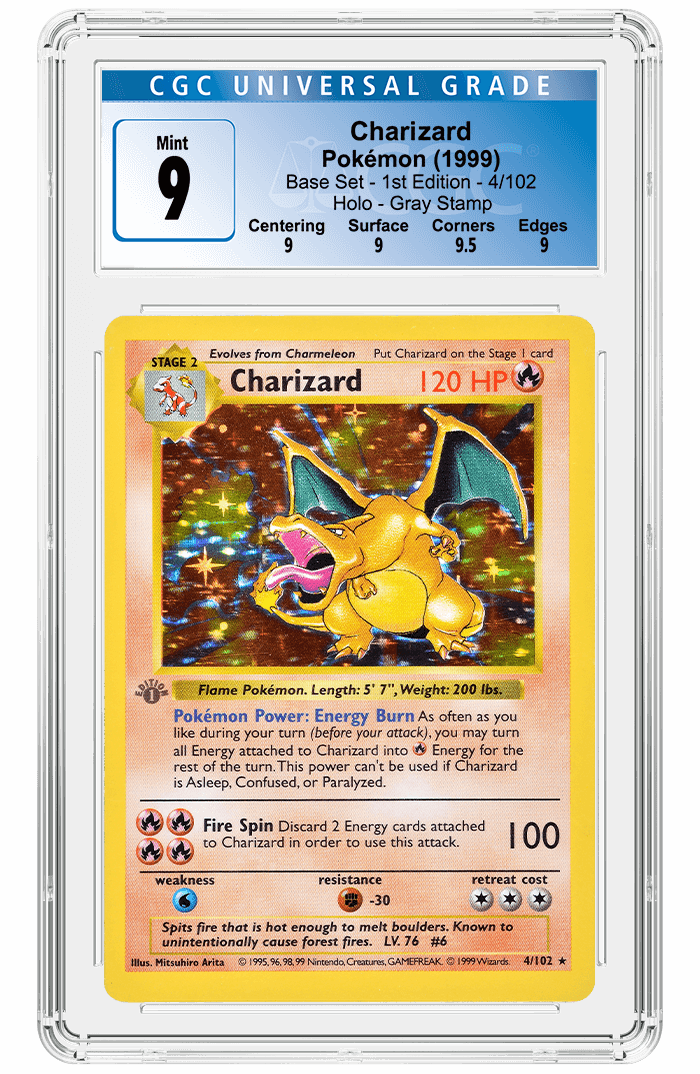Wow! CGC Trading Cards Grades Ultra-rare Cards from Pokémon and Yu-Gi-Oh!
Posted on 5/30/2023
CGC Trading Cards® receives a large number of submissions every day from collectors and dealers seeking expert authentication, grading and encapsulation services for their trading cards. Sometimes, these submissions include rarities that are scarcely seen, even in the grading room. One submitter recently sent in no less than ten vintage Pokémon and Yu-Gi-Oh! cards. Six of the cards earned a grade of CGC Pristine 10 or Perfect 10, and each one offers a bit of nostalgia or insight about the TCG’s history. Continue reading to learn more about each of these fantastic cards.
Yu-Gi-Oh!
Red-Eyes Black Dragon
The Yu-Gi-Oh! Trading Card Game was released in North America in March 2002, nearly two years after the anime began airing on American TV stations. Fans were already familiar with the anime’s characters, including Joey Wheeler — an eccentric boy and best friend of the main protagonist, who uses the powerful Red-Eyes Black Dragon to sweep his opponents in the fictional game of Duel Monsters.
When the first set of the Yu-Gi-Oh! TCG revealed that Red-Eyes Black Dragon would be included as one of the ten available secret rare cards, fans went wild. They eagerly flocked to card stores to try to pull the elusive dragon. Unfortunately, they’re called “secret rare” cards for a reason; there was only a 1/12 chance of pulling a secret rare from a Legend of Blue-Eyes White Dragon pack, and a 1/10 chance that it would be Red-Eyes Black Dragon after that!
Those who did manage to pull Red-Eyes Black Dragon from the 1st Edition set walked away with an excellent card to use in their decks. Unfortunately, the amount of playability that Red-Eyes Black Dragon saw in early Yu-Gi-Oh! TCG tournaments resulted in damaged cards, and many have degraded over time. In a testament to how well this card was taken care of, this submitter's Red-Eyes Black Dragon, Yu-Gi-Oh! (2002) North American English Legend of Blue Eyes White Dragon – LOB-070 Ultra Rare – 1st Edition – Glossy earned a grade of CGC Pristine 10 with near-perfect subgrades.
Pokémon
Charizard, Pokémon Topsun No Number and Prism Holo
Soon after the release of Pokémon Red and Green in Japan, a Japanese candy production company called Top-Seika began producing their own line of Pokémon cards. These cards, called Pokémon Topsun, were distributed in packs of apple-flavored chewing gum. There were 150 cards to collect, with each card featuring one of the original 150 Pokémon, excluding Mew.
The submitter sent two Pokémon Topsun Charizard cards to CGC Trading Cards for grading. These included a Charizard, Pokémon Topsun (1997) Original Series No Number – 1st Print graded CGC Pristine 10 with near-perfect subgrades, and a Charizard, Pokémon Topsun (1997) Original Series Prism Holo graded CGC Perfect 10.
Both of these Topsun Charizard cards are extremely rare and valuable. The holographic Topsun cards, like the Prism Holo Charizard, could only be found in 1 out of every 20 packs. Meanwhile, the other Charizard lacks a Pokédex number beside the name at the top. This denotes that this Charizard comes from the 1st print run of the Topsun cards. They're also in stellar condition, considering that they're over 25 years old.
To learn more about Pokémon Topsun, click here.
Charizard, Pokémon (1996) Japanese Base Set Holo signed by Mitsuhiro Arita
There’s nothing more iconic than the original Charizard Base Set Holo. It is one of the most sought-after cards in the Pokémon TCG, and for good reason. Besides its nostalgic value to fans, it’s also one of the most expensive cards in the game. This submitter sent in a Charizard, Pokémon (1999) Base Set 1st Edition Holo, and it earned a grade of CGC 7.5.
Yes, Base Set Charizard is very special. However, the Japanese Charizard may blow every other Base Set Charizard out of the water in terms of value. This Charizard, Pokémon (1996) Japanese Base Set Holo is autographed by none other than Mitsuhiro Arita, the artist behind Base Set Charizard’s iconic portrait. The front of the card features Arita’s signature, a sketch of Charizard’s head with its mouth open and the date it was signed: 11.5.22.
Because CGC Trading Cards did not witness the signature, the Charizard earned a grade of CGC Pristine 10 Qualified with near-perfect subgrades. To learn more about what a “Qualified” grade means, click here.
Kangaskhan (Garura) Parent / Child Tournament Prize Holo
In the summer of 1998, The Pokémon Company held a qualifying tournament in Japan for participants to earn their way to a national event that would be held in the fall. The event was called the Kamex (Blastoise) Mega Battle and consisted of a large Pokémon TCG tournament and several side events.
One of these events was the Kangaskhan Parent/Child Tournament, a small side tournament that players could participate in while they waited for their matches in the main event. The side competition paired children and adults in a 2v2 tag team match, with the top eight teams going home with a special promo card.
This card was the Kangaskhan Garura Parent/Child Tournament Prize Promo Holo, a special card that was distributed during this tournament and the one before it — the Lizardon Mega Battle held a few months beforehand in the spring. The tournament winner received two copies — one each for the parent and child — while each of the other seven teams went home with one copy each. Between the Lizardon and Kamex Mega Battle tournaments, there were only 20 of these cards officially distributed.
This Kangaskhan Garura Parent/Child Tournament Prize Promo Holo earned a grade of CGC 9.5, making it the highest-graded example in the CGC Trading Cards Population Report.
University Magikarp
From April 1998 to March 1999, Shogakukan — a Japanese media company responsible for publishing CoroCoro Comic and other Pokémon-related media — ran a campaign in which children could “enroll” in a fictional university for the chance to win prizes. This competition was known as the Tamamushi (Celadon) University Magikarp Campaign, and the prizes revolved around the Pokémon Magikarp — the University’s mascot.
Every month, CoroCoro Comic would include information about the Tamamushi University campaign, with several of the issues containing exams. Different levels of exams were included in each issue, with levels ranging from first to sixth grade. Those who completed the exam could tear out the paper they wrote on and mail it to an address written in the magazine. Examinees would be mailed back a score result and, if they passed, a welcome letter to Tamamushi University (if it was the Entrance Exam) or a prize.
Students who made it all the way to the Hyper Professor Exam in December 1998 and passed received a copy of this University Magikarp, Pokémon (1998) Japanese Tamamushi University Hyper Test promo card. These promo cards were also given away by other means, including a lottery and an online version of the exam.
This University Magikarp, Pokémon (1998) Japanese Tamamushi University Hyper Test Day Two Prize earned a grade of CGC 9.5 with sub-grades of 9 for Centering, 10 for Surface, 10 for Corners and 9.5 for Edges. It is the highest-graded example in the CGC Trading Cards Population Report.
Crystal Charizard and Torchic Gold Star
The years 2003 and 2004 marked the beginning of the “Dark Ages” of the Pokémon TCG. Pokémon’s popularity as a franchise was at an all-time low, which contributed to a lack of sales and slower production of the Pokémon TCG. New sets like Skyridge and EX Team Rocket Returns suffered shorter print runs due to smaller funds.
Crystal Charizard and Torchic Gold Star are both secret rare cards with low chances of being pulled from a booster pack. Fans had one chance in every two booster boxes to pull Torchic Gold Star from the EX Team Rocket Returns set, or in other words, a pull rate of 1 in every 72 packs. The Japanese Crystal Charizard is almost as difficult to find, as it had a pull rate of 1 out of every 40 booster packs of Mysterious Mountains.
This Charizard, Pokémon (2002) Japanese Mysterious Mountains 1st Edition Holo earned a grade of CGC 9.5, which is the highest-graded example in the CGC Trading Cards Population Report. Meanwhile, the Torchic Gold Star, Pokémon (2004) EX Team Rocket Returns Holo earned a grade of CGC Pristine 10 with near-perfect subgrades. It is the only CGC Pristine 10 example in the CGC Trading Cards Population Report, with none graded higher.
Mega Tokyo’s Pikachu
Last, but certainly not least, is the submitter’s Mega Tokyo’s Pikachu!
Another card given out as a participation prize in a tournament, Mega Tokyo’s Pikachu was awarded to participants of the Pokémon Center Mega Battle + Creatures Challenge held in Pokémon Centers across Japan in 2016. Forty participants of all age groups could join one of three tournament sessions, and each walked away with the Mega Tokyo’s Pikachu as a participation prize. There are known to be 960 copies of this promo Pikachu in circulation.
The Mega Tokyo's Pikachu promo is actually a reprint of Mega Tokyo's Pikachu 098/XY-P with new artwork. The original was printed to celebrate the relocation of Pokémon Center Tokyo from Hamamatsuchō to Ikebukuro in 2014 and was given away to customers who purchased something from the new location for a limited time. The Mega Tokyo's Pikachu that was given away as a participation prize in the Mega Battle + Creatures Challenge is arguably rarer than its Pokémon Center counterpart.
CGC Trading Cards has graded a total of 7 examples of Mega Tokyo’s Pikachu, Pokémon (2016) Japanese XY & XY BREAK Promos – 204/XY-P Mega Battle + Creatures Challenge. This one earned a grade of CGC Perfect 10, the highest-graded example in the CGC Trading Cards Population Report.
Related Articles:
Stay Informed
Want news like this delivered to your inbox once a month? Subscribe to the free CGC eNewsletter today!















